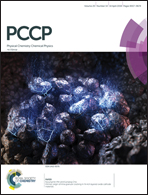Design of iron atom modified thiophene-linked metalloporphyrin 2D conjugated microporous polymer as CO2 reduction photocatalyst†
Abstract
Herein, by means of density functional theory (DFT) calculations, we designed a new type of thiophene-linked porphyrin unit and incorporated it into an extended 2D conjugated microporous polymer (CMP) to serve as a CO2 reduction catalyst. This newly designed catalyst combines the advantages of molecular catalysis, heterogeneous catalysis, high structural stability and tunable electronic properties. A series of metal atoms (Fe, Mg, Mn, and Cu) were introduced into the center of the porphyrin ring to modify its capacity for reducing CO2. Our transition state (TS) search calculations revealed that the Fe-modified CMP possessed the highest catalytic activity toward CO2 reduction. The plausible reduction pathway was also determined. The band structure and frontier orbital distribution calculations further demonstrated its semimetallic property and higher stimulated transition probability, both of which are critical factors for photocatalytic performance. We hope that our design could provide meaningful guidance for other relevant CO2 catalytic reactions.



 Please wait while we load your content...
Please wait while we load your content...